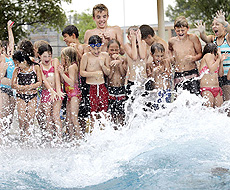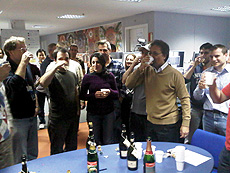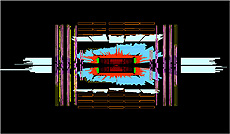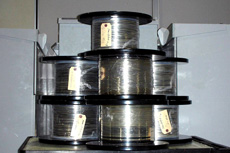|
Have a safe day!
Friday, Nov. 13
8:30 a.m.
Presentations to the Physics Advisory Committee - Curia II
3:30 p.m.
DIRECTOR'S COFFEE BREAK - 2nd Flr X-Over
4 p.m.
Joint Experimental-Theoretical Physics Seminar - One West
Speaker: Michael Eads, University of Nebraska
Title: New Higgs Results from DZero
8 p.m.
Fermilab Lecture Series - Ramsey Auditorium - $7
Speaker: Craig Hogan, Fermilab
Title: The Sounds of Spacetime: Black Holes, Early Universe, Cosmic Strings, and Holographic Noise
Monday, Nov. 16
THERE WILL BE NO PARTICLE ASTROPHYSICS SEMINAR THIS WEEK
3:30 p.m.
DIRECTOR'S COFFEE BREAK - 2nd Flr X-Over
4 p.m.
All Experimenters' Meeting
Special Topics: Recent Antiproton Lifetimes in the Recycler Ring; MDB Roof Repairs Update; CMS/LHC Report - Curia II
Click here for NALCAL,
a weekly calendar with links to additional information.
|
|
For information about H1N1, visit Fermilab's flu information site.
|
|
Friday, Nov. 13
- Chorizo burrito
- Old-fashioned ham and bean soup
- Philly-style chicken
- Chicken pot pie
- Baked fish over rice
- Roasted veggie and provolone panini
- Assorted slices of pizza
- Baked potatoes
Wilson Hall Cafe menu |
|
Wednesday, Nov. 18
Lunch
- Scallops with chipotle-orange sauce
- Yellow pepper rice
- Steamed broccoli
- Coconut cake with caramel sauce
Thursday, Nov. 19
Dinner
- Egg drop soup
- Asian braised beef short ribs
- Roasted new potatoes
- Sautéed spinach
- Lemon napoleon
Chez Leon menu
Call x3524 to make your reservation.
|
|
|
Making a splash
 |
A good cannonball can soak spectators, and a beam splash in CMS can soak scientists with good data. Physicists can use the data to verify detector calibration and make sure the electronics are synchronized with the beam. |
From my Uncle Eddy's first cannonball into the pool each summer, to singer Susan Boyle's now-legendary performance, to make a splash means to be noticed. Recent splashes at CMS have highlighted the return of beam at the LHC and, believe me, CMS scientists noticed.
In the fall of 2008, an electrical arc substantially damaged the LHC accelerator. During the last year, accelerator scientists repaired the damage and have made some modifications to prevent such incidents from happening again. It's been a year marked by growing anticipation for the return of the beam. The wait is now over.
In recent weeks, the LHC accelerator team has been turning the accelerator complex back on, first bringing the beam to the entrance of the LHC and then guiding the beam around longer and longer fractions of the accelerator ring. Between Nov. 7-9, they successfully steered the beam around half of the ring, bringing it to the very doorstep of CMS. The beam collimators were intentionally closed, thus stopping the beam from actually passing through the detector. This was done as a safety precaution so that scientists could check the beam's trajectory before allowing it to enter the detector.
While the collimators stopped the beam from directly entering CMS, the debris caused by the beam hitting the collimators passed through the detector. Like with the splash caused by my Uncle Eddy soaking bystanders, the particle splash thoroughly penetrated the CMS detector.
The beam was run into the collimators more than 1,100 times, bathing the detector in particles. Using the splash, which deluged the detector with far more particles than during ordinary operations, CMS scientists were able to study their equipment and verify it worked under very extreme conditions.
During the next few weeks, scientists will open the collimators and circulate beam around the entire ring. A few days later, CMS scientists will make two counter-rotating beams of protons collide in the center of the LHC's various detectors.
The era of the LHC is fast approaching.
— Don Lincoln
 |
| CMS physicists celebrate the return of beam in the time-honored way of drinking good champagne out of bad glasses in the middle of the night. |
 |
| This colorful image is an example of how CMS responds to beam splash. The beam entered from the right, lighting up the detectors. |
|
Virtually attend SC09
Can't attend SC09 next week, and eager to hear what's going on in the world of supercomputing?
You can attend virtually via international Science Grid This Week's iSGTW@SC09 page, which goes live tomorrow.
Here's how:
- Follow our team Twitter account, @isgtw, for pint-size live updates on the conference.
- Whether you use Twitter or not, you can follow our updates between 8:30 a.m. and 6 p.m. Tuesday through Thursday on our Web page.
- Keep up with SC09 blogs, courtesy of our partners at GridCast.
|
Fermilab asking for
neighbors' input in planning
From the Daily Herald, Nov. 12, 2009
Fermilab is looking for advice from its neighbors.
It is compiling a community advisory board to help make plans for the accelerator laboratory's future, particularly when its famous Tevatron accelerator ceases operations in 2010.
The panel will meet starting in January. Nomination forms are available at fnal.gov/pub/neighbors/CAB, or by calling (630) 840-3351. Nominations are due Dec. 7.
Read more
|
Did a time-traveling bird sabotage the collider?
From Time, Nov. 11, 2009
Sometime on Nov. 3, the supercooled magnets in sector 81 of the Large Hadron Collider (LHC), outside Geneva, began to dangerously overheat. Scientists rushed to diagnose the problem, since the particle accelerator has to maintain a temperature colder than deep space in order to work. The culprit? "A bit of baguette," says Mike Lamont of the control center of CERN, the European Organization for Nuclear Research, which built and maintains the LHC. Apparently, a passing bird may have dropped the chunk of bread on an electrical substation above the accelerator, causing a power cut. The baguette was removed, power to the cryogenic system was restored and within a few days the magnets returned to their supercool temperatures.
Read more
|
|
|
Wire contracts placed for high-field magnet project
 |
| Oxford Superconducting Technology, of Carteret, N.J., produced these seven spools of BSSCO-2212 superconducting wire. The company will ship the wire to Fermilab for cabling. |
Fermilab has placed contracts for the first orders of a superconducting wire scientists hope to use in the next generation of high-performance magnets.
With funding through the American Recovery and Reinvestment Act, Fermilab purchased 3,900 meters of the wire from Oxford Superconducting Technology of Carteret, N.J., and Supercon of Shrewsbury, MA, two manufacturers that specialize in the production of superconductors for scientific and medical applications. The total order amounts to roughly $185,306.
Fermilab expects to receive wire shipments in January and February for eventual distribution to collaborators in the Very High Field Superconducting Magnet Collaboration for testing. Collaborators want to know how the silver-sheathed wire, which contains hundreds of filaments of bismuth strontium calcium copper oxide, or BSCCO-2212, performs once in cable form.
Researchers are particularly interested in the superconductor for its use in the next generation of particle accelerators, such as a proposed muon collider, which will need high-field magnets 5 to 10 times as powerful as today's niobium-based magnets. BSCCO-based superconductors can also operate at higher temperatures than today's magnets, which operate at temperatures close to absolute zero.
"We've pushed niobium to its limit," said Fermilab's John Tompkins, who managed purchasing for the wire. "Now we're trying to work with industry to develop conductors that can be used in these high-field magnet applications."
Fermilab will arrange 24 strands of the 0.8-millimeter wire into a flat cable, a process that takes a few days. Other institutions in the collaboration will bake the wire, causing it to become superconducting, and then send a portion of the wire back to Fermilab for testing.
Because the material is still in research and development, scientists want to find the right mix of raw materials, manufacturing techniques, cabling and baking, said Technical Division's Emanuela Barzi.
"This material is still under development, so there are many things that need to be optimized," Barzi said.
— Chris Knight
 |
As part of Fermilab's role in the collaboration, technicians will arrange 24 silver-sheathed 0.8 millimeter BSCCO-2212 wire into a Rutherford cable, pictured above. Each 0.8 millimeter strand contains between 700 and 1,000 filaments, depending on the manufacturer.
|
Visit Fermilab's Recovery Act Web site. |
Hosts, guests wanted for Thanksgiving dinner match
International Services will play matchmaker this Thanksgiving between volunteers at Fermilab who are hosting Thanksgiving dinners and those at Fermilab without Thanksgiving plans.
The program is open to anyone at Fermilab, domestic or international, user, employee or contractor, said International Services Supervisor Amanda Petersen.
"This matches people who have no Thanksgiving plans with those people having Thanksgiving dinner who want to share," Petersen said.
Peterson came up with the idea based on her own experiences in college. She often didn't go home for Thanksgiving and ended up hosting dinner for other students.
It won't be the first time Fermilab locals have opened up their homes on Thanksgiving. Steve Carrigan, a technician in the ES&H section, advertised in Fermilab Today last year inviting anyone to join in his Thanksgiving dinner. He received an unexpected response.
"I got responses, but all of them were from people off site who read Fermilab Today and wanted to spend time with people from Fermilab," Carrigan said.
Carrigan said three people replied to his invitation, but only one ended up coming. He thinks making the process an organized event will help match more Fermilab users up with host families this year.
Hosts and guests interested in joining the program should visit turkeydate.fnal.gov to fill out a short questionnaire about dietary restrictions, transportation arrangements and other topics. There is one questionnaire for potential hosts, and one for potential guests. International Services will announce matches from Nov. 18 to 24.
— Chris Knight |
|